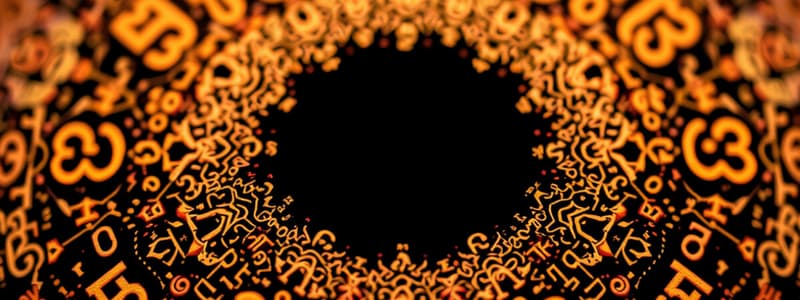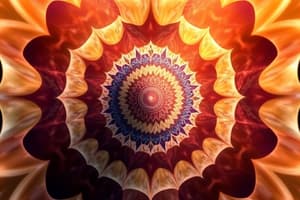Podcast
Questions and Answers
What does the term 'pattern' refer to in the context of numbers and the world?
What does the term 'pattern' refer to in the context of numbers and the world?
- A non-repetitive sequence of events
- An arrangement that helps predict outcomes (correct)
- A random collection of data points
- A chaotic arrangement of elements
Which of the following best describes the Fibonacci Sequence?
Which of the following best describes the Fibonacci Sequence?
- A series where each number is the product of its two predecessors
- A pattern relating to prime numbers only
- A mathematical series that includes only even numbers
- A sequence formed by the sum of the previous two numbers (correct)
What characteristic of patterns does G.H. Hardy emphasize?
What characteristic of patterns does G.H. Hardy emphasize?
- Patterns are purely artistic without any mathematical significance
- Patterns are only found in linguistic structures
- Patterns exist in multiple forms including sequential and spatial (correct)
- Counting is independent of patterns
What are regularities in the world primarily related to?
What are regularities in the world primarily related to?
Which of the following patterns is NOT associated with natural phenomena?
Which of the following patterns is NOT associated with natural phenomena?
What is the formula related to the generation of the Fibonacci Sequence?
What is the formula related to the generation of the Fibonacci Sequence?
Which of the following statements best describes symmetries in nature?
Which of the following statements best describes symmetries in nature?
What does the term 'man-made design' refer to in the context of patterns?
What does the term 'man-made design' refer to in the context of patterns?
What is the value of the irrational number known as Phi?
What is the value of the irrational number known as Phi?
Which structure is known for incorporating the Golden Section in architecture?
Which structure is known for incorporating the Golden Section in architecture?
Who introduced Set Theory in mathematics?
Who introduced Set Theory in mathematics?
What does the symbol ε denote in Set Theory?
What does the symbol ε denote in Set Theory?
What characteristic of mathematical language refers to expressing complex thoughts with relative ease?
What characteristic of mathematical language refers to expressing complex thoughts with relative ease?
In Set Theory, how is a set typically represented?
In Set Theory, how is a set typically represented?
What does the term 'mathematical expression' refer to?
What does the term 'mathematical expression' refer to?
What is the main purpose of mathematical language?
What is the main purpose of mathematical language?
What is the correct definition of the intersection of two sets A and B?
What is the correct definition of the intersection of two sets A and B?
What is the correct symbol for the complement of set A?
What is the correct symbol for the complement of set A?
If set A contains elements {1, 2} and set B contains {2, 3}, what is A ∩ B?
If set A contains elements {1, 2} and set B contains {2, 3}, what is A ∩ B?
What characterizes an empty set?
What characterizes an empty set?
What does the notation A - B represent?
What does the notation A - B represent?
How is the cardinality of set A defined for finite sets?
How is the cardinality of set A defined for finite sets?
Which statement correctly defines a universal set?
Which statement correctly defines a universal set?
What does the union of two sets A and B include?
What does the union of two sets A and B include?
Which method is used to list the elements of a set, where each element is separated by a comma?
Which method is used to list the elements of a set, where each element is separated by a comma?
What is a finite set characterized by?
What is a finite set characterized by?
Which notation is used to describe the members of a set based on a specific rule or condition?
Which notation is used to describe the members of a set based on a specific rule or condition?
What does it mean if a sentence is described as an open sentence?
What does it mean if a sentence is described as an open sentence?
What characterizes an infinite set?
What characterizes an infinite set?
How is the intersection of two sets A and B defined?
How is the intersection of two sets A and B defined?
What does ellipsis represent in set notation?
What does ellipsis represent in set notation?
Which of the following statements about closed sentences is true?
Which of the following statements about closed sentences is true?
Flashcards are hidden until you start studying
Study Notes
Numbers and Patterns
- Patterns help predict observations or events, combining concepts of regularity and counting.
- G.H. Hardy, a British mathematician, described mathematics as the study of patterns.
Patterns in Nature
- Patterns can be sequential, spatial, or temporal, often repeating through recognizable structures.
- Regularities indicate that similar outcomes occur under consistent conditions.
Fibonacci and Natural Patterns
- Leonardo of Pisa, known as Fibonacci, discovered the Fibonacci Sequence, which describes rabbit breeding patterns: 1, 1, 2, 3, 5, 8, 13...
- The Fibonacci Sequence follows the rule: Xn = Xn-1 + Xn-2.
Golden Ratio and Mathematics
- The Golden Ratio, approximately 1.618, relates two quantities where the ratio is the same as the larger quantity to their sum.
- Seen in architecture like the Parthenon and the Great Pyramid of Egypt, showcasing symmetry and proportion.
Mathematical Language
- Mathematics communicates ideas through a precise system of symbols and rules.
- Set theory, developed in the 1870s, studies collections of objects called sets, introduced by Georg Cantor.
Set Theory Basics
- Sets are defined using braces {} with elements denoted as members or elements.
- Different representation methods include:
- Roster Method: Lists each element, e.g., A = {a, e, i, o, u}.
- Rule Method: Describes properties of elements, e.g., A = {x | x is a collection of vowel letters}.
Types of Sets
- Finite Set: Limited countable elements, e.g., A = {1, 2, 3}.
- Infinite Set: Unbounded elements, e.g., A = {0, 1, 2, ...}.
- Unit Set: Contains only one element, e.g., A = {1}.
- Empty Set: Contains no elements, denoted as ∅.
Set Operations
- Intersection (A ∩ B): Elements common to both sets.
- Union (A ∪ B): Combines all elements of both sets.
- Difference (A - B): Elements in A that are not in B.
- Complement (A′): All elements not in set A.
- Equal Sets: Have the exact same elements.
Additional Concepts
- Cardinality: Number of elements in a set, denoted as n(A).
- Universal Set (U): Contains all elements under consideration.
- Subset: A set formed from elements of another set.
Mathematical Conventions
- Established facts and notation facilitate clear communication among mathematicians.
- An open sentence has an uncertain truth value, while a closed sentence has a definitive truth value.
Studying That Suits You
Use AI to generate personalized quizzes and flashcards to suit your learning preferences.




